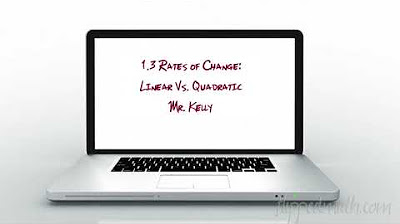Wavelength-Frequency-Speed Relationship
Summary
TLDRIn this video tutorial, Mr. H explores the relationship between wavelength, frequency, and speed in waves. Using practical examples, he demonstrates how the speed of a wave is calculated using the formula V = F × λ, where V is speed, F is frequency, and λ is wavelength. Through wave experiments, he shows how wave speed depends on the medium, not the frequency or wavelength. He also explains the inverse relationship between frequency and wavelength. Finally, a practical problem involving boats in a harbor illustrates how to calculate wavelength, frequency, and speed in real-world scenarios.
Takeaways
- 😀 The relationship between wavelength, frequency, and speed is given by the equation: Speed = Frequency × Wavelength.
- 😀 The speed of a wave is determined by the medium, not the frequency or wavelength.
- 😀 When the frequency of a wave increases, the wavelength decreases, and vice versa, as they are inversely proportional.
- 😀 The speed of a wave can be calculated by rearranging the equation: Speed = Frequency × Wavelength.
- 😀 The equation Speed = Frequency × Wavelength can also be used to find frequency and wavelength if the other two quantities are known.
- 😀 In practical problems, the speed of waves in different media will vary, even if frequency and wavelength change.
- 😀 In the example of ocean waves reaching the shore, the frequency of 15 waves per minute and a wavelength of 12 meters gives a speed of 3 meters per second.
- 😀 The medium through which a wave travels (such as zinc or copper coils in a Slinky experiment) affects its speed, regardless of frequency or wavelength.
- 😀 Doubling the frequency of a wave results in halving the wavelength, while the speed remains constant for the same medium.
- 😀 A practical example involving two boats shows how wavelength, frequency, and speed are interconnected, with the distance between the boats being 1.5 wavelengths, allowing for the calculation of the wave's properties.
Q & A
What is the fundamental equation relating wavelength, frequency, and speed of a wave?
-The fundamental equation is V = F × λ, where V is the speed of the wave, F is the frequency, and λ is the wavelength.
What does the speed of a wave depend on?
-The speed of a wave depends on the properties of the medium through which it is traveling, not just the frequency or wavelength.
How are frequency and period related?
-Frequency (F) and period (T) are reciprocals of each other. The period is the inverse of the frequency: T = 1/F.
What happens to the wavelength if the frequency of a wave doubles while traveling through the same medium?
-If the frequency doubles, the wavelength is halved, as frequency and wavelength are inversely proportional when the wave speed is constant.
Can the speed of a wave change if the frequency or wavelength changes?
-No, the speed of a wave does not change with changes in frequency or wavelength. The speed remains constant for a given medium, even if the frequency or wavelength changes.
How is the speed of ocean waves calculated when given the frequency and wavelength?
-The speed of ocean waves can be calculated using the equation V = F × λ, where F is the frequency and λ is the wavelength. For example, if the frequency is 0.25 Hz and the wavelength is 12 meters, the speed would be 3.0 m/s.
What is the relationship between frequency, wavelength, and wave speed in the same medium?
-In the same medium, wave speed (V) is constant. Frequency (F) and wavelength (λ) are inversely proportional. If the frequency increases, the wavelength decreases, and vice versa.
What happens when the medium through which a wave travels is changed?
-When the medium is changed, the speed of the wave changes. For example, changing from a zinc slinky to a copper slinky changes the speed, even if the frequency and wavelength remain the same.
What is the frequency of a wave if one complete cycle occurs every 10 seconds?
-The frequency of the wave would be the reciprocal of the period. If one complete cycle occurs every 10 seconds, the frequency would be 1/10 = 0.1 Hz.
How can the wavelength of a wave be determined from the distance between two boats oscillating in a harbor?
-To determine the wavelength from the distance between two boats, you need to know how many wavelengths fit between them. For example, if the distance between the boats is 18 meters and it corresponds to 1.5 wavelengths, the wavelength is 18 meters ÷ 1.5 = 12 meters.
Outlines

此内容仅限付费用户访问。 请升级后访问。
立即升级Mindmap

此内容仅限付费用户访问。 请升级后访问。
立即升级Keywords

此内容仅限付费用户访问。 请升级后访问。
立即升级Highlights

此内容仅限付费用户访问。 请升级后访问。
立即升级Transcripts

此内容仅限付费用户访问。 请升级后访问。
立即升级浏览更多相关视频

Motion Characteristics of a Projectile

AP Precalculus – 1.3 Rates of Change Linear and Quadratic Functions

How to Add, Subtract, Multiply, and Divide Decimals | A Review of Decimals | Math with Mr. J

CARA MUDAH BEDAIN THEY, THEY’RE, THEIR, DAN THERE - Kampung Inggris LC | Teatu

Create checkerboard pattern in Photoshop tutorial how to

How To Solve ⚠️ This unlicensed Adobe app has been disabled || Photoshop 2024 | 2025

How to Solve One-Step Inequalities | Math with Mr. J
5.0 / 5 (0 votes)
